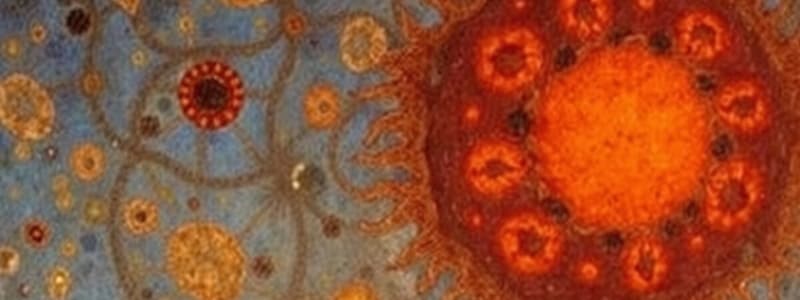Podcast
Questions and Answers
What is the primary function of the rough endoplasmic reticulum?
What is the primary function of the rough endoplasmic reticulum?
- Photosynthesis
- Energy production
- Protein synthesis (correct)
- Lipid synthesis
The plasma membrane surrounds the nucleus in a eukaryotic cell.
The plasma membrane surrounds the nucleus in a eukaryotic cell.
False (B)
What organelle is responsible for ATP synthesis during aerobic cellular respiration?
What organelle is responsible for ATP synthesis during aerobic cellular respiration?
Mitochondrion
The __________ contains digestive enzymes and aids in waste disposal.
The __________ contains digestive enzymes and aids in waste disposal.
Match the following organelles with their functions:
Match the following organelles with their functions:
Which organelle is involved in the storage of starch?
Which organelle is involved in the storage of starch?
Cilia are long, whip-like structures that provide propulsion.
Cilia are long, whip-like structures that provide propulsion.
What is the function of the endomembrane system?
What is the function of the endomembrane system?
Which of the following statements about the organelle systems is correct?
Which of the following statements about the organelle systems is correct?
The nuclear envelope is composed of a single lipid bilayer.
The nuclear envelope is composed of a single lipid bilayer.
What is the primary function of the endomembrane system?
What is the primary function of the endomembrane system?
The main component of the primary cell wall is __________.
The main component of the primary cell wall is __________.
What type of vesicle contains enzymes that digest fatty acids and amino acids?
What type of vesicle contains enzymes that digest fatty acids and amino acids?
Ribosomes are present on the smooth endoplasmic reticulum (ER).
Ribosomes are present on the smooth endoplasmic reticulum (ER).
Where in the cell can small amounts of DNA be found alongside the nucleus?
Where in the cell can small amounts of DNA be found alongside the nucleus?
Match the following structures with their primary functions:
Match the following structures with their primary functions:
Flashcards are hidden until you start studying
Study Notes
Cell Organelles and Functions
- Organelles are functional structures found within the cytosol of the cell.
- The plasma membrane serves as a protective barrier surrounding the cytoplasm.
- The nuclear envelope consists of two lipid bilayers and encloses the nucleus in eukaryotic cells, allowing selective passage of molecules.
Endomembrane System
- Comprises interacting organelles: nucleus, rough ER, smooth ER, vesicles, golgi body, and plasma membrane.
- Main functions include lipid and protein synthesis, enzyme production, toxin detoxification, and waste elimination.
Endoplasmic Reticulum (ER)
- ER is an extension of the nuclear envelope; has two forms:
- Rough ER: studded with ribosomes, involved in protein synthesis and folding.
- Smooth ER: lacks ribosomes; functions in lipid synthesis and metabolism.
- Cells engaged in high protein production contain abundant ER.
Vesicles and Vacuoles
- Vesicles are small membrane-bound organelles involved in transport, storage, and digestion.
- Various types of vesicles include:
- Transport vesicles: move proteins to organelles and the plasma membrane.
- Peroxisomes: contain enzymes to digest fatty and amino acids; play a role in breaking down hydrogen peroxide.
- Vacuoles are specialized vesicles in plants, acting as storage for waste and maintaining cell turgor pressure.
Lysosomes
- Small membrane-bound organelles that contain digestive enzymes.
- Aid in waste disposal by fusing with vacuoles to digest contents.
Golgi Body
- Composed of folded membranes responsible for the final packaging of proteins.
- Receives molecules from the endoplasmic reticulum, processes them, and prepares for transport.
Mitochondria and Plastids
- Mitochondria: double-membraned organelles responsible for ATP synthesis through aerobic respiration.
- Plastids are membrane-bound organelles in plants for storage and photosynthesis, including:
- Chloroplasts: site of photosynthesis, containing pigments and enzymes.
- Chromoplasts: synthesize and store pigments other than chlorophyll.
- Amyloplasts: store starch.
Cytoskeleton and Motility Structures
- The cytoskeleton is a network of filaments providing structural support, facilitating cell movement, and helping with cell division.
- Microfilaments: made of actin, contribute to cellular shape and motility.
- Flagella: whip-like structures aiding in propulsion for both prokaryotic and eukaryotic cells.
- Cilia: small hair-like structures that move water and mucus, aiding in locomotion for microorganisms.
Cell Structure and Communication
- The cell wall forms an outer protective layer in plant cells, comprising a primary cellulose layer and a thicker secondary wall for added rigidity.
- The extracellular matrix (ECM) supports and protects cells, facilitating intercellular communication through cell junctions.
- Cytosol refers solely to the liquid within the cell, while cytoplasm encompasses the liquid and organelles, excluding the nucleus.
Nucleus and Protein Management
- Majority of DNA is housed in the nucleus; some is found in mitochondria and chloroplasts.
- The nuclear envelope regulates the production of RNA and proteins, controlling access to genetic material.
- Nucleoplasm, housed within the nucleus, provides a medium similar to cytosol, essential for nuclear functions.
Studying That Suits You
Use AI to generate personalized quizzes and flashcards to suit your learning preferences.




